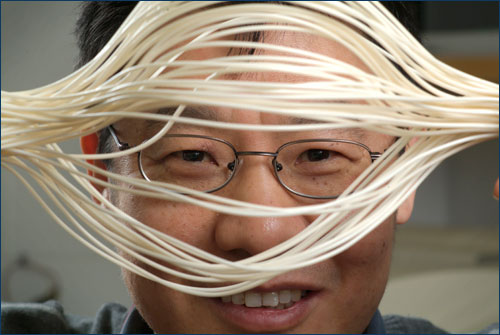
Pure, clean water. Many people take it for granted, but newly arrived engineering professor Sheng Chang knows it’s not always easy to achieve. As the world population grows and water consumption rises accordingly, it’s becoming increasingly important to find new ways to treat waste water and make it usable again, he says.
“My research focus is on using membranes in combination with other techniques to treat water and waste water,” says Chang, who joined U of G in January.
It’s research with direct practical applications, and his career has included both academic and industrial positions.
Born in China, he did his undergraduate work in chemical engineering at Chengdu University of Science and Technology. After graduation, he worked at the Fourth Chemical Engineering Corporation for four years before becoming a lecturer in food engineering at Hunan Light Industrial College.
A position as a visiting researcher at the University of New South Wales in Australia eventually led him to enrol in the graduate program there. He completed his PhD in 2001 and did a post-doctoral stint at New South Wales before moving to Canada to work for Zenon Environmental in Oakville.
“I was excited about coming to Zenon because it was a world leader in membrane bioreactor technology for waste-water treatment,” says Chang.
He worked in the technology department, reporting to the chief technical officer with a focus on new technology evaluation and development for future commercialization. In 2006, however, Zenon was acquired by General Electric, and his role changed. “Once GE took over the company, my work was more focused on the current membrane bioreactor technology and trying to make it more efficient.”
The membrane bioreactor, an advanced technology for waste-water treatment, makes the treatment more efficient, plants more compact and the treated water cleaner. The major challenge, however, is that as water is filtered through the membrane, the particles, colloids and macromolecules being removed from the waste water get stuck to the outside of the membrane — similar to how the filter in a furnace or vacuum cleaner eventually gets clogged, says Chang. In the membrane bioreactor, the organic matter produced by the biomass can form a gel-like layer on the outside of the membrane, blocking the pores so that water can no longer flow through.
“Our goal was to keep the membrane as clean as possible so it keeps on working,” says Chang. “My research looked at the physical and chemical properties of the membrane, the biomass and the foulant materials to see if we could change anything to prevent the membranes from being blocked.”
Here at Guelph, Chang is interested in doing more work to understand the fundamentals of membrane and biological technology for waste-water treatment.
“In industry, they want the fast straight solution,” he says. “In a university environment, you can look at the fundamental mechanisms of what’s happening and maybe find new ways of enhancement.”
Joining the faculty of U of G gives him an opportunity to explore these processes while maintaining his close ties to GE.
“I think it’s a very good combination,” he says. “You can bridge the two, building on both the fundamentals and the commercial applications.”
To understand his research, you need to know a bit about how membranes have been used in waste-water treatment. Currently, the membrane is made into a bundle of hollow tubes and placed in the middle of the concrete tank where water is being treated. Bacteria are put into the water to “eat” the organic compounds for their energy requirement and growth, and oxygen is injected for bacterial respiration. The membrane retains the bacteria inside the tank.
“This process is fairly fast, but that doesn’t mean it’s efficient based on the energy consumption,” says Chang. “The bacteria grow rapidly, and it’s costly to treat the biomass produced as a waste product in this process.”
He’s interested in looking at using anaerobic and other processes — ones that require no or much less oxygen to be injected into the water.
“The major drawback is that the biomass grows slowly without oxygen, but it consumes less energy and produces less waste.”
Chang says membranes may help the anaerobic techniques for waste-water treatments. “If you want to push the technology forward and move to the next stage, you have to do this kind of fundamental research.”
When he’s not helping to make water cleaner, the engineer likes to play sports to keep in shape.
“I play basketball and badminton. I’m not very good, but I like the exercise. I also like to swim and walk, and I appreciate all the excellent parks and walking trails around Guelph and the University.”